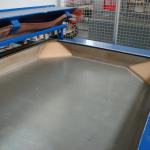Lay-up tableManually or automatically moved table to feed a membrane press. Before the pressing process, the table needs to be charged properly with pre-glued work pieces and the desired coating material. If there is no pin-system available, suitable spacers have to be used. Then the table is moved into the press and the pressing process gets started. In the next step the table leaves the press and the parts can be cut-out. By varying the numer and configuration of the tables, cycle times and working load of the press can be changed. The following options exist:
Additional enhancements are possible. Bürkle for instance rotates the table after pressing (multi-turning). That puts aside the rotation of the work pieces in order to be able to cut-off the film. Normal lay-up tables allow a work piece height up to 70 mm, depending on the manufacturer. When using a higher frame, moulded parts up to 200 mm height can be pressed. That means the membrane is exposed to bigger stress which leads to faster wastage. |
CNC machining centres, robots872
Edgebanding, edge processing595
Saws, cutting machines425
Planers, 4-sided moulders187
Routers, shapers, tenoners, profilers179
Drilling, mortising machines127
Presses, clamps, joining machines197
Sanding machines316
Mechanisation, storage, packing technology176
Surface coating143
Production lines118
Heating, drying, waste chopping57
Dust extraction, compressed air, vacuum114
Assembly, worktables11
Lathes35
Tools, sharpening technology80
Equipment, Other machines44



